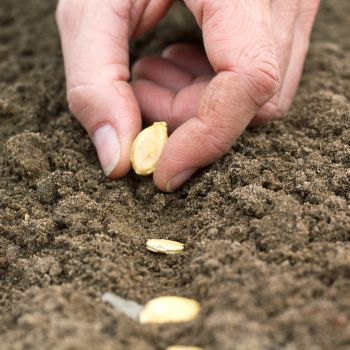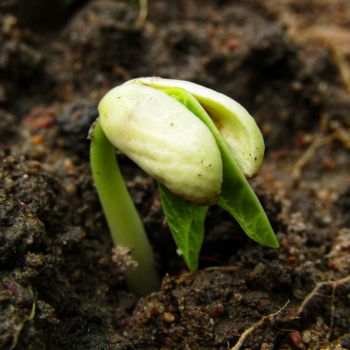Many gardeners choose to start their seeds in punnets, trays or containers. This is essential if you’re starting seeds indoors or in a greenhouse. But it can also be a good option if growing outdoors, as you can grow seedlings while other crops are maturing, grow them in a protected space, and you have control over where and when to plant them out. Of course, this means choosing a suitable container to host your seeds, and to give your seedlings a good start it's important to choose wisely.
Some seeds are happy to be sown in small containers, crowded together and then separated out later for transplanting. Some plants prefer to start off in larger pots with less competition, where disturbance when transplanting won't be as great. Some plants with long or delicate roots don't take kindly to being started in pots at all, such as melon, radish and most root vegetables.
For the many seeds which can benefit from a few weeks of cossetted container growing, how do you decide which pot, punnet, or tray to sow in? Here are the main points to think about when making your choice.
Thrifty and Sustainable Options
There's not necessarily a need to buy containers, especially if you're only sowing a few seeds at a time. Many household items can be reused or recycled to make containers that are sustainable as well as thrifty.
- Empty toilet rolls can be used as biodegradable pots for seedlings with longer roots, such as climbing beans and peas.
- Newspaper can be rolled into ‘pots’ of varying sizes that will also break down after transplanting, or you can use a paper pot maker for a more professional result.
- Eggshells can be used to start smaller plants, also providing nutrition and soil improvement when planted out.
- Egg cartons make good biodegradable punnets for small, fast-germinating seeds.
- Non-biodegradable containers such as yoghurt pots or milk cartons can be used for seedlings, giving them another role in life before heading for the recycling bin. Make sure to put small holes in the bottom of containers for drainage.
While these options are inexpensive and eco-friendly, for serious seed-raising work many gardeners prefer to choose a ready-made option.
What to Consider for Bought Pots and Containers
There are quite a few things to consider when choosing the container for each of the seeds you want to sow. As always with gardening, it's about finding the right balance for your needs, with no necessarily right or wrong answers.
Cost
One of the great advantages of growing from seed is the savings you can make compared to buying established seedlings, but this saving can be undone if you overspend on the containers. Think about whether more expensive options will give you enough benefit to justify the cost, or whether something a little more cheap and cheerful would be equally as good.
Sustainability
At first glance, a plastic pot might not seem as sustainable as a biodegradable container, but remember that plastic can be reused many times, which lowers the overall cost and spreads out the resources used in production. To make plastic a more eco-friendly choice, be sure to buy sturdy containers that will last for several years without splitting or cracking, wash them between uses, and store them out of sunlight when not in use.
Ease of Use
If you're sowing large numbers of seeds you want your containers to be convenient to use, and also simple to store out of season. Some types of pots can be messier to handle than others, or may require closer attention to watering and feeding.
Number and Type of Seeds
If you're sowing many types of plants but only a few seeds of each, you'll probably want punnets or pots that make it easy to group the different species together. On the other hand, if you're sowing a large number of one or two kinds of seed, then a container that makes the best use of space would be a better choice, and will likely also be more economical.
Matching Punnet and Drip Trays
One final point to note is that most containers will also need to sit on a drip tray to collect excess water, and punnets can be easier to organise and handle if stored in the correct punnet tray. It can be a good idea to purchase punnets and corresponding trays together, for example 10 water saver punnets will fill a 10-cavity punnet tray.
Choosing the Material
Seedling pots are available in three main material types: coir, biodegradable jiffy pots, and plastic. Each has its good and bad points.
Coir Seed Starters
Made from recycled coconut husks held in place with a fibre mesh, coir seed starters are a biodegradable option that lets the seedling be planted out whole to reduce transplant shock. The coir is sterile to avoid pathogen problems including damping off, and are also simple to use as they require only water and no additional compost.
However, the lack of soil is also a drawback. As there are no nutrients to feed the seedlings, you'll either need to use a liquid plant food or transplant the seedlings when they're still small and vulnerable. Also, the coir can dry out quickly compared to soil in plastic punnets, so they require extra care and attention compared to traditional pots.
Almost any kind of seed can be sown in coir, but in general, smaller seeds sown near or on the surface work best, including lettuce, tomatoes and soft herbs.
Jiffy Pots or Strips
Made from compressed wood pulp fibre, jiffy pots or strips are another biodegradable option that can be transplanted whole to avoid root damage. They're a little more versatile than coir starters, as they're available in a range of sizes from single large pots to strips with smaller compartments. What's more, you can choose which kind of compost to fill them with to provide the seeds with all the nutrients they need.
However, as a single-use option they can work out to be relatively costly, and overwatering can lead to the pots becoming soggy, making them difficult to handle. Nonetheless, they are a good choice for nearly any plant that doesn't like being transplanted, including beans, zucchini, tomatoes and more.
Plastic Seedling Trays and Punnets
Plastic seedling trays are perhaps the most common option for home gardeners. They're reusable to offset their non-biodegradable nature, and are available in a variety of sizes and formats to suit a large range of seeds. They can be bought as single large trays for broadcasting small seeds, or trays ready-divided into sections to keep the plants' root systems apart. Watering is straightforward as the soil tends to hold moisture well, and bottom-watering is usually an option so you don't need to check moisture levels as often.
The two main drawbacks are that there's a higher risk of transplant shock when teasing the seedlings out, and also disease can build up with reuse unless the trays are thoroughly disinfected each time they’re used.
Plastic trays are good for starting all kinds of seeds with relatively shallow root systems, including tomatoes, herbs, zucchini chilli and capsicum.
Choosing Between the Plastic Punnet Options
If you decide that a plastic seed tray or punnet is the best option for you, the next question is which size and shape of container to use.
- Seedling Trays: Offering a single compartment to fill with your choice of compost mix, seed trays are good for scattering numerous seeds of a single type, for later thinning out and transplanting to larger pots or the open soil.
- Multi-Cell Punnets: These divide the tray into separate compartments, keeping the root systems of each seedling separate for easier transplanting. Multi-cell punnets are available most commonly with six, ten, or 24 cells in one tray.
- Water Saver Punnets: These punnets offer a halfway house between ordinary trays and multiple cells. Each punnet takes up a row or two in a larger tray and is good for sowing four to six seeds of a single variety, with several plant types sharing a single tray for easier watering. They’re a good choice if you’re growing a few plants each of a lot of different varieties.
- Squat Punnets: These punnets are similar to water savers, but a little deeper and squarer to accommodate single plants. Squat punnets are ideal for growing tomato, cucumber, zucchini, and other plants that are best transplanted once they've reached a good size. Again, several squat punnets will fit into a single drip tray.
- Forestry or Propagation Tubes: Lastly, these pots are used to grow larger individual plants including trees and shrubs. Because they are deeper and have more room for roots, plants can be kept in the tubes for longer than in punnets. Forestry tubes are the deeper of the two types and are often used to grow trees with long tap roots such as eucalyptus.
There's plenty to think about when growing plants from seed, but it's hugely satisfying to see a mature plant develop from its earliest stages. Picking the right container to start the process will have a huge influence on your overall success, so it's important to choose carefully.
.jpg)
.jpg)
.jpg)
.jpg)





